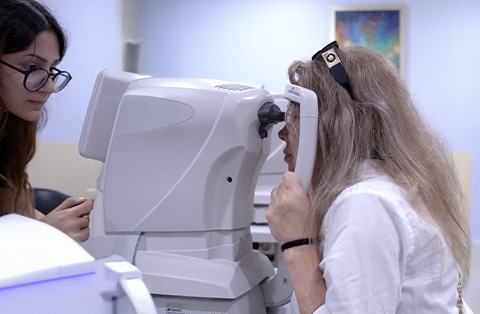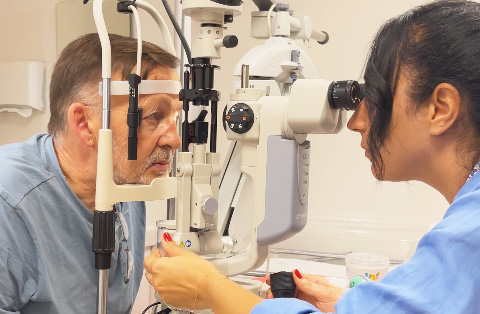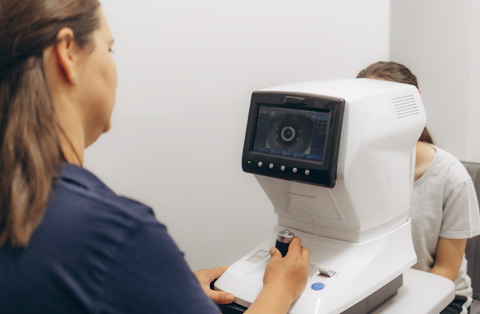Tired of glasses or contacts? LASIK offers a fast, safe way to restore clear vision permanently. Discover how this life-changing laser surgery can free you from daily visual limits.
What is LASIK Eye Surgery?
LASIK (Laser-Assisted In Situ Keratomileusis) is a type of laser eye surgery that corrects vision problems such as myopia (nearsightedness), hyperopia (farsightedness), and astigmatism. It reshapes the cornea, which is the clear front part of the eye, to allow light entering the eye to be properly focused onto the retina.
It is one of the most common and well-known procedures to reduce or eliminate the need for glasses or contact lenses. The goal is to improve vision by correcting the refractive error of the eye.
LASIK is a quick and usually painless procedure. It is performed using a special laser that changes the shape of the cornea in just a few minutes. Most patients experience improved vision within 24 to 48 hours following lasik surgery.
Who Is a Good Candidate for LASIK?
A good candidate for LASIK is someone who wants to reduce or eliminate their dependence on glasses or contact lenses and has a stable eye prescription. Not everyone is suitable for LASIK. A thorough eye examination is needed to determine if the procedure is safe and likely to be effective.
Ideal candidates usually meet the following criteria:
Are 18 years or older
Have had a stable vision prescription for at least one year
Have healthy corneas thick enough for the procedure
Do not have eye diseases such as glaucoma, cataracts, or severe dry eye
Are not pregnant or breastfeeding
Are in good general health and free of autoimmune disorders that may affect healing
People with very high prescriptions or irregular corneas may need other types of laser refractive surgery. In some cases, LASIK may not be recommended. An eye specialist will help decide the best option after detailed tests.
Which Vision Problems That Can Be Corrected with LASIK?
LASIK corrects common refractive errors by reshaping the cornea so that light focuses properly on the retina. It helps the eye see more clearly without the need for glasses or contact lenses.
These are the main vision problems LASIK can treat:
Myopia (nearsightedness): You can see nearby objects clearly, but distant objects appear blurry. LASIK flattens the cornea to reduce the eye's focusing power.
Hyperopia (farsightedness): You can see distant objects clearly, but nearby objects are blurry. LASIK steepens the cornea to improve near vision.
Astigmatism: This causes blurred vision or distorted vision at all distances due to an irregularly shaped cornea. LASIK smooths the cornea into a more regular shape. Read more about Laser Eye Surgery for Astigmatism Correction
LASIK can treat mild to moderate degrees of these conditions. If your prescription is too high or your cornea is too thin, other options may be more suitable.
Age Considerations: When Is the Right Time for LASIK?
Age plays an important role in deciding the right time for LASIK. The procedure is generally recommended for adults whose vision has stabilized.
Minimum Age Requirement:
LASIK is approved for individuals who are 18 years or older. However, most eye surgeons prefer to perform the operation on patients in their early 20s or older. This is because vision changes can still occur during the late teens.
Vision Stability:
Your glasses or contact lens prescription should be stable for at least one year before LASIK. If your vision is still changing, the results of the laser surgery may not last.
Ages 20s to 40s:
This is considered the ideal age range for LASIK. Most people in this group have stable vision and healthy eyes.
Ages 40 and above:
From the mid-40s, the eye’s natural lens begins to lose flexibility. This leads to a condition called presbyopia, which makes it harder to see up close. LASIK does not treat presbyopia. Some patients in this age group may need reading glasses after LASIK, or consider other procedures like monovision LASIK.
Older Adults:
Patients over 60 may be at higher risk of age-related eye conditions such as cataracts. In such cases, lens replacement surgery may be a better option.
The best time for LASIK is when your vision is stable, your eyes are healthy, and you are not experiencing age-related changes in focus. A detailed eye exam will help determine if this is the right time for you.
Who Should Avoid It?
LASIK is not suitable for everyone. Some conditions and risk factors can increase the chance of complications or reduce the effectiveness of the surgery.
People who should avoid LASIK include:
Unstable Vision: If your prescription changes frequently, LASIK may not give lasting results.
Thin or Irregular Corneas: The laser reshapes the cornea, so it must be thick and regular enough for safe treatment.
Severe Dry Eye Syndrome: LASIK can worsen dryness, which may affect healing and comfort.
Certain Eye Conditions: Glaucoma, keratoconus, and advanced cataracts are usually contraindications.
Autoimmune Diseases: Conditions like lupus or rheumatoid arthritis can slow healing and increase complications.
Pregnant or Breastfeeding Women: Hormonal changes can affect vision and healing, so it’s best to wait.
Under 18 Years Old: Vision is often still changing in younger patients.
Each patient must undergo a full eye examination. The eye surgeon will decide if LASIK is safe and suitable based on individual findings.
How Much Does LASIK Eye Surgery Cost?
The cost of LASIK eye surgery can vary widely depending on the country, the clinic's reputation, the surgeon’s experience, and the technology used. Prices usually cover pre-operative exams, the surgery itself, and post-operative check-ups.
Here is a general comparison of average costs:
United States: LASIK typically ranges from medium to high cost. Clinics often charge per eye. Advanced technologies can increase the price. In the U.S., LASIK surgery typically ranges from $1,500 to $5,000 per eye, depending on the specific procedure and the clinic.
United Kingdom: Costs are similar to the US, with private clinics offering packages based on the type of laser used. In the UK, the cost for LASIK surgery varies between £1,495 and £3,100 per eye, influenced by the clinic's location and the technology used.
Western Europe: Prices vary by country, but generally remain in the same range as the UK and US. Germany and France tend to be at the higher end. In countries like Germany, the average cost of LASIK surgery is approximately €3,000 per eye, reflecting the high standards of medical care in the region.
Türkiye: Türkiye offers LASIK surgery at more affordable rates, typically ranging from $1,000 to $1,500 per eye. Many clinics use the same advanced technology and follow international medical standards. Surgeons in Türkiye are highly experienced, and many are trained in Europe or the US.
Despite being more affordable, Türkiye offers world-class quality. Clinics use advanced laser technologies and follow international safety standards. Surgeons are highly experienced, often trained abroad. This makes Türkiye a popular destination for patients seeking both quality and affordability in LASIK surgery.
Does Insurance Cover Laser Eye Surgery or Refractive Surgery?
In most cases, insurance does not cover LASIK or other types of refractive surgery. These procedures are usually considered elective, meaning they are not medically necessary. Insurance providers view them as optional because glasses or contact lenses can also correct vision.
Cost-Benefit Analysis: LASIK vs. Lifetime Cost of Glasses and Contacts
LASIK may seem expensive at first, but it can be more cost-effective in the long run compared to wearing glasses or contact lenses for life.
Glasses and Contact Lenses: Ongoing Costs
Over the years, the cost of prescription glasses, contact lenses, cleaning solutions, and eye exams adds up. On average:
Glasses need replacement every 1 to 2 years.
Contact lens users spend on lenses and solutions regularly.
Eye exams are needed to keep prescriptions up to date.
For someone using contact lenses daily, the lifetime cost can reach several thousand dollars.
LASIK: One-Time Investment
LASIK is a one-time procedure. While the upfront cost is higher, there are no recurring expenses. Most patients no longer need glasses or lenses after the surgery.
Long-Term Value
Within a few years, the cost of LASIK can equal or even be lower than the ongoing expense of glasses or contacts. More importantly, LASIK offers:
Greater freedom and comfort
Convenience for sports and travel
Long-term vision correction with high patient satisfaction
For many, LASIK is not just a medical decision but a smart financial choice that improves quality of life.
What Happens During a LASIK Procedure?
The LASIK procedure is quick and usually completed within 15 to 30 minutes for both eyes. It is performed under local anesthesia using numbing eye drops. Here’s a step-by-step look at what happens:
1. Preparation
You lie down on a reclining chair. The surgeon applies numbing drops to your eyes. A lid speculum is used to keep the eyes open.
2. Creating the Flap
A thin flap is created on the surface of the cornea. This can be done using a microkeratome blade or a femtosecond laser. The flap is then gently lifted to expose the underlying corneal tissue.
3. Reshaping the Cornea
An excimer laser is used to reshape the cornea with high precision. The laser removes microscopic amounts of tissue based on your unique prescription. This step takes just a few seconds.
4. Repositioning the Flap
After reshaping, the flap is carefully repositioned. It naturally adheres without stitches and begins healing immediately.
5. Post-Procedure
You rest briefly after the procedure. Most patients notice improved vision within 24 to 48 hours. A follow-up appointment is scheduled to monitor healing.
The entire process is painless, and vision recovery is usually fast. Most people return to normal activities within a couple of days.
What Are the Risks and Potential Complications of LASIK Surgery?
LASIK is considered a safe and effective procedure when performed by experienced surgeons using advanced technology. Most patients achieve excellent results without serious complications. However, as with any surgery, there are risks.
Common Side Effects (Usually Temporary)
Dry eyes
Glare, halos, or starbursts at night
Light sensitivity
Blurry vision in the first few days
Mild discomfort or irritation
These effects typically improve within a few weeks.
Less Common Complications
Overcorrection or undercorrection
Infection or inflammation
Flap complications (such as folds or dislocation)
Regression of vision over time
Difficulty with night vision
Severe complications are rare, especially with proper patient selection and modern laser systems. Follow-up care is important to monitor healing and manage any side effects.
LASIK is not a difficult or high-risk procedure for most patients. But a thorough eye exam and honest discussion with your surgeon are essential to ensure it is the right choice for your eyes.
How Long Does LASIK Last and Will Vision Changes Occur Later?
LASIK results are long-lasting for most patients. The cornea is permanently reshaped, so the corrected vision is usually stable for many years.
Long-Term Stability
Most people enjoy clear vision without glasses or contact lenses for at least 10 to 20 years. Many never need additional surgery. If your prescription was stable before LASIK, the outcome is more likely to remain stable after the procedure.
Age-Related Changes
Over time, your eyes may still change due to natural aging. For example:
Presbyopia: Starting in your 40s, the eye’s lens loses flexibility, making it harder to focus on close objects. This is not related to LASIK and affects everyone.
Cataracts: In older age, lens clouding can affect vision, but this also is unrelated to LASIK.
Enhancement Procedures
In some cases, a second LASIK or enhancement may be needed if your vision changes or if the first surgery did not fully correct your prescription. This is rare and typically considered only when the cornea is still healthy and thick enough.
In summary, LASIK provides long-term vision correction. While it does not stop the natural aging of the eye, most patients enjoy many years of improved sight.
What's the Difference Between LASIK and Other Vision Correction Surgeries?
LASIK is the most well-known laser vision correction procedure, but it’s not the only one. Other options exist for people who may not be good candidates for LASIK or who have different needs.
Key Differences
1. LASIK (Laser-Assisted In Situ Keratomileusis)
A flap is created in the cornea
The underlying cornea is reshaped with a laser
Fast recovery, minimal discomfort
Suitable for mild to moderate myopia, hyperopia, and astigmatism
2. PRK (Photorefractive Keratectomy)
No flap is created
The outer layer of the cornea is removed and the laser reshapes the surface
Slightly longer recovery and more discomfort
Preferred for patients with thinner corneas or high-risk jobs
3. SMILE (Small Incision Lenticule Extraction)
A small piece of tissue (lenticule) is removed through a tiny incision
No flap, less invasive than LASIK
Suitable mainly for myopia and astigmatism
Faster healing of the corneal surface
4. ICL (Implantable Collamer Lens)
A lens is implanted inside the eye, without removing corneal tissue
Reversible procedure
Suitable for high refractive errors or thin corneas
Choosing the Right Option
The best procedure depends on your eye structure, lifestyle, and vision needs. An experienced ophthalmologist can recommend the most suitable treatment after a full eye exam.
How Is Recovery Like After LASIK Eye Surgery?
Recovery after LASIK is usually quick and straightforward. Most patients notice clearer vision within 24 hours. However, full healing may take a few weeks.
Immediately After Surgery
Vision may be blurry or hazy
Mild discomfort, burning, or itching is common
Sensitivity to light and watery eyes can occur
You should rest and avoid touching your eyes
First 24–48 Hours
Most patients return to normal daily activities within 1 to 2 days
You may need to wear eye shields while sleeping to protect the healing flap
Eye drops are used to prevent infection and reduce inflammation
First Few Weeks
Dry eyes and glare at night may continue
Avoid swimming, hot tubs, and makeup around the eyes
Follow-up visits will monitor healing and vision quality
Long-Term Care
Vision continues to stabilize over several weeks
Most side effects fade within the first month
Regular eye exams help ensure lasting results
Recovery is usually smooth if post-operative instructions are followed closely. Most people return to work and everyday tasks quickly, with minimal disruption.
Frequently Asked Questions
Ask the ExpertCan you get LASIK twice?
Yes, LASIK can be done a second time, known as an enhancement, if vision changes or the initial correction wasn't fully effective. However, it depends on factors like corneal thickness and overall eye health. A thorough evaluation is needed to determine eligibility.
Is SMILE better than LASIK?
SMILE and LASIK are both effective, but each has advantages. SMILE is less invasive, with no corneal flap, which reduces dry eye risk and healing time. LASIK provides faster vision improvement and treats a wider range of vision issues. The choice depends on individual needs.
Is LASIK painful?
No, LASIK is not painful. Numbing eye drops are used during the procedure to ensure you don't feel discomfort. You may experience mild pressure or slight irritation during and after surgery, but this usually subsides within a few hours. Most patients describe it as painless.
What age is too late for LASIK?
There isn't a specific "too late" age for LASIK, but it's usually not recommended after age 60 due to age-related eye conditions like cataracts. Patients in their 40s and beyond may develop presbyopia, requiring reading glasses even after LASIK. A thorough eye exam will determine eligibility.
Can LASIK go wrong?
While LASIK is generally safe, complications can occur, though they are rare. Potential risks include dry eyes, glare, halos, or under/over-correction. Choosing a skilled, experienced surgeon reduces the likelihood of these issues and ensures a successful outcome.
Does LASIK give you 20/20 vision?
LASIK often provides 20/20 vision or better, but results can vary based on individual factors like the severity of your vision problem. While many patients achieve perfect vision, some may still need glasses for specific tasks, like reading or night driving.
Does LASIK go bad in 10 years?
LASIK results generally remain stable for many years. However, age-related changes like presbyopia or cataracts may affect vision over time. While vision may shift slightly in some patients, the majority experience long-lasting improvement without issues 10 years after surgery.
How long does LASIK last?
LASIK provides long-lasting results, typically permanent. However, natural aging can cause vision changes over time, especially after age 40, when conditions like presbyopia may develop. Most patients enjoy stable vision improvement for many years post-surgery.
Is Turkey good for laser eye surgery?
Yes, Turkey is an excellent destination for laser eye surgery. It offers high-quality care with experienced, board-certified ophthalmologists, advanced technology, and affordable prices. Many clinics also provide all-inclusive packages for international patients.
Is LASIK painful?
LASIK is not painful. Numbing eye drops are used during the procedure to prevent discomfort. You may feel slight pressure or a mild sensation for a few seconds. After surgery, some patients experience dryness or irritation, but this usually improves within a few days with proper care and medication.
Can I open my eyes after LASIK?
Yes, you can open your eyes immediately after LASIK. Your vision may be blurry at first, and you may feel mild discomfort or sensitivity to light. It’s important not to rub your eyes. Follow your surgeon’s advice and use prescribed drops to support healing and protect your vision.
Does LASIK fully fix eyesight?
LASIK significantly improves eyesight by correcting refractive errors like myopia, hyperopia, and astigmatism. Most patients achieve 20/20 vision or better. However, it may not guarantee perfect vision for everyone. Age-related changes like presbyopia can still occur, and some may need reading glasses or minor enhancements later in life.
Is LASIK eye surgery safe?
Yes, LASIK is considered a safe procedure with a high success rate when performed by experienced surgeons. Serious complications are rare. Most side effects are mild and temporary. Proper patient selection, modern laser technology, and careful follow-up help ensure both safety and effective long-term results.
How long does LASIK eye surgery last?
LASIK eye surgery provides permanent correction for the existing vision problem. For most patients, results last for many years. However, natural age-related changes like presbyopia or cataracts may affect vision later. Some may need enhancements years later, but most enjoy stable vision without glasses for a long time.
When Can You Resume Normal Activities After Laser Eye Surgery?
Most patients can resume normal activities within 1 to 2 days after LASIK. Reading, working on a computer, and light exercise are usually fine. Avoid swimming, eye makeup, and contact sports for at least a week. Follow your surgeon’s advice to protect healing and ensure the best results.



